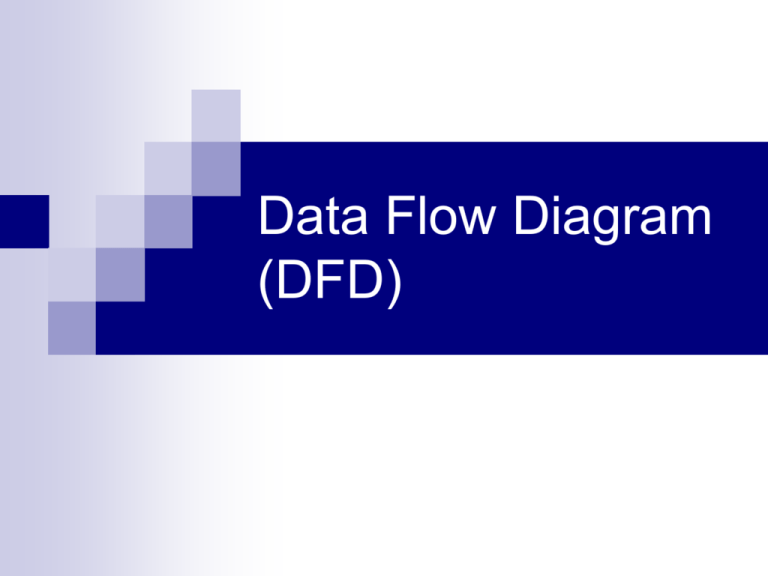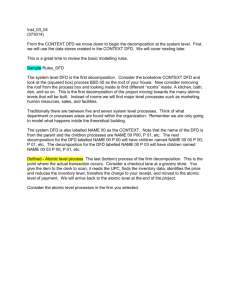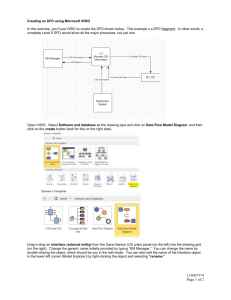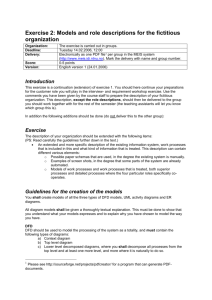Data Flow Diagram (DFD)
advertisement

Data Flow Diagram (DFD) Data Flow Diagram (DFD) A DFD is a graphical representation of how the data flows through a system. DFD is one of the first steps carried out when developing an information system. DFD displays details like the data that is coming in and going out of the system, how the data is travelled through the system and how the data will be stored in the system. The main components included in a DFD are processes, data stores, data flow and external entities. The context level DFD is the first level that is drawn first. The first level DFD displays how the entire system interacts with external data sources and data sinks. The next Level 0 DFD is developed by expanding the context level DFD. Level 0 DFD contains details of the sub-systems within the system and how the data is flowing through them. It also contains details about the data stores required within the system. 2 Data Flow Diagram [Example] Staff 3 Data Flow Diagrams [DFD Notation] The DFD is a diagram that consists principally of four symbols, namely the external entity, the data flow, the process and the data store Additionally, a physical flow can be shown on the DFD of the current system 4 Data Flow Diagrams [External Entities] Staff 5 Data Flow Diagrams [Data Flows] Data Flow (usual) Customer Details Bi-directional Flow (rare) Flow Between External Entities (for convenience) Resource Flow (for convenience) Goods Cosmetic 6 Data Flow Diagrams [Process] 1 Terminal Check Customer 7 Data Flow Diagrams [Data Stores] Digitized D Manual M1 T1 Transient Duplicate D1 Orders Customer DB Stock File Unpaid Invoices D1 Orders 8 Data Flow Diagrams [Decomposition] 9 Data Flow Diagrams [Decomposition] A closer look at process 1 of the Small Stock System also shows that it is logically consistent and does indeed describe the activity of ordering stock On the other hand, it does not contain enough detail to understand exactly what happens when stock is ordered 10 Data Flow Diagrams [Decomposition] For example: Is there any time lapse between the production of a stock list and a firm order coming back? When does a check of the product files take place? Who is responsible for choosing which supplier to use? The DFD deals with these issues by allowing more detailed views of the high level processes This is done by breaking up each process into as many sub-processes as deemed necessary 11 Data Flow Diagrams [Decomposition] Any process on a DFD may be broken up into several sub-processes which, when viewed collectively, make up that process Thus for example we may break-up process 1 of the Small Stock System into that shown on the next slide: 12 Data Flow Diagrams [Decomposition - Levelling] e Manager 1 Order Stock Stock List 1.1 1.2 Produce Stock List Stock List M2 Purchase Order Stock File Record Purchase Order * * Purchase Order M1 Purchase Order Cabinet 13 Data Flow Diagrams [Decomposition - Levelling] The decomposition of a DFD into lower level DFDs is known as levelling The DFD that shows the entire system is known as the ‘top level’ or ‘level 1’ DFD The DFDs that contain more detailed views of the level 1 processes make up ‘level 2’ DFDs Any level 2 process that is further decomposed gives rise to a level 3 DFD and so on 14 Data Flow Diagrams [Decomposition – Elementary Process Description (EPD)] They will contain enough detail for a program specification to be deducible from them at a later stage As such, a clear description of each one has to be produced at some time during the analysis These Elementary Process Descriptions (EPDs) are written in plain English, or in pseudocode, depending on the project team. A sample EPD follows: 15 Data Flow Diagrams [Decomposition – Elementary Process Description (EPD)] Elementary Process Description System: Small Stock Process Name: Record Purchase Order DFD Type: Current Process Id: 1.2 Managers give the stock clerk a ready-made purchase order. The stock clerk places this order in the Purchase Order Cabinet. It is the managers’ responsibility to send the order directly to the supplier they have chosen. Each purchase order contains product information taken from the supplier’s price list. The date after which a delivery of goods will be unacceptable is also included. 16








